There’s no such thing as a “perfect formula” to get a successful business whether you have just started or you’ve been struggling to create strategies for years to establish your brand.
Maintaining a business is tougher than anyone could think. It requires extraordinary efforts to establish and maintain.
One thing you must understand is you have to keep trying and learning from experts till you could make your business stand out.
Focus on Contribution Margin for Long Term Growth
According to the latest data as of 2022, businesses that have joined the e-commerce industry had a failure rate of 48.4%.
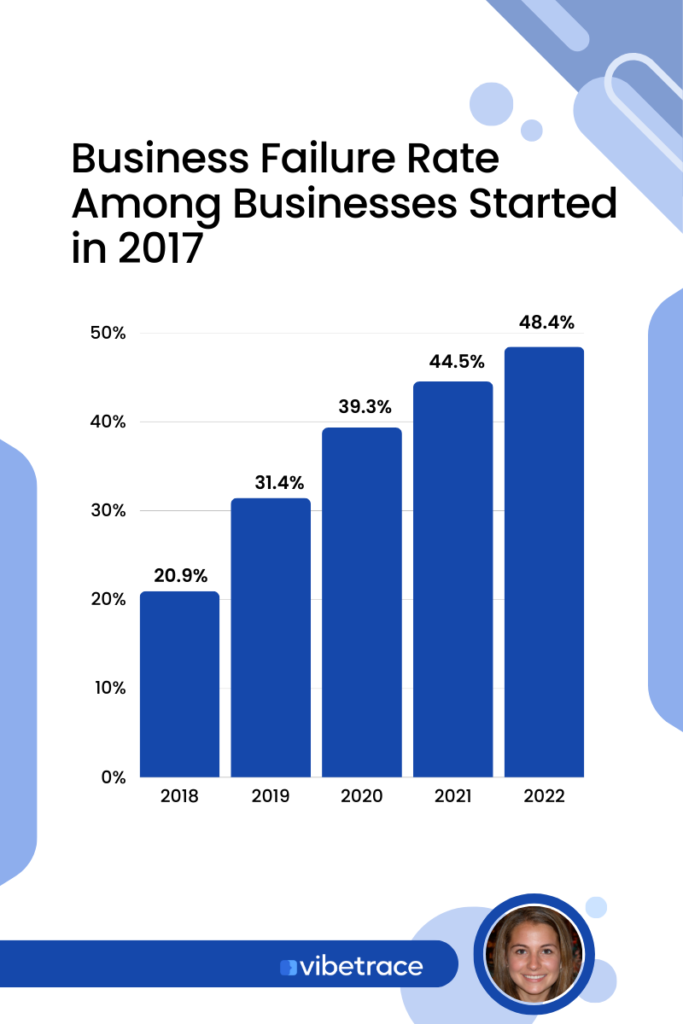
In a recent LinkedIn post, Oscar Guerero, owner of an e-commerce marketing agency, drew attention to the common mistake made by e-commerce businesses where they prioritize short-term profit over long-term sustainability.
He argued that this approach is “mathematically impossible” because customer lifetime value (LTV) cannot be achieved in just one month.
He mentioned that Ryan Rouse suggested that businesses should focus on contribution margin to measure the profitability of their advertising efforts.
The contribution margin is a metric that calculates the revenue earned from sales minus the variable costs associated with producing and delivering the products. Not enough brands are paying attention to this metric and instead are focusing on siloed channel performance, which can lead to a “recipe for disaster.”
Relying solely on siloed channel performance can be problematic because it doesn’t take into account the overall impact of advertising efforts on the business’s profitability.
Instead, businesses should focus on contribution margin, which provides a more accurate measure of the effectiveness of advertising efforts across all channels.
Although, when focusing solely on the existing customer base to increase contribution margin, it may not lead to sustainable growth in the long run.
This approach may be necessary for liquidating stale inventory or improving cash flow, but should not be relied on as a long-term strategy. Brands must be willing to sacrifice immediate profits for long-term sustainability.
One way to measure if a brand is relying too heavily on its existing customers is by tracking Net Active Customers, which should not reach 0 or become negative.
13 Psychological Principles for Email Marketing
Chase Dimond, a renowned email marketer, recently shared valuable insights on how his agency has generated over $100M in revenue for clients through email marketing.
In a LinkedIn post, he disclosed 13 uncommon psychological principles that have proven to be instrumental in achieving such success.
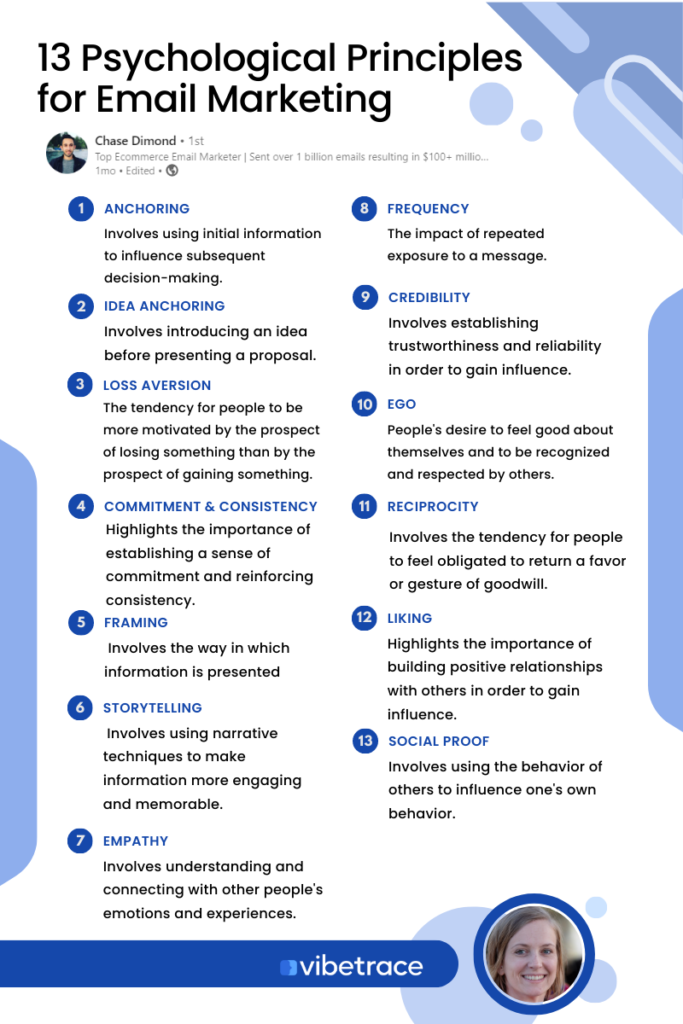
According to Dimond, these principles are frequently used in their copy and have led to exceptional results. If you’re interested in learning more about these principles and how they can improve your email marketing strategy, read on.
/form
Want to be up to date with Marketing?
Subscribe to our Retail CX newsletter!

Stay connected with what’s really important to optimize your digital revenues.
By clicking the button, you accept our Terms & Conditions. Also you will need to confirm your email address.
Here are the 13 Psychological Principles for Email Marketing
Anchoring
When making a decision, people tend to rely on the first piece of information they receive.
While most people are not familiar with the concept of price anchoring – where a seller presents a high-priced option to make the cheaper options seem more attractive.
An example could be a complete makeup set with multiple items priced at $200. By presenting this set as the first option, you are anchoring the customer’s perception of the value of the other makeup product. This makes the other makeup products seem more affordable, even if they are still relatively expensive.
Idea Anchoring
You can also influence the amount someone’s willing to pay by anchoring idea in their mind.
Although this can be quite challenging and may take a while because you need a unique idea.
A few of the examples by companies are:
Diamond companies – “An engagement ring should cost 3 month’s salary”
Toothbrush companies – “A toothbrush should be replaced every 90 days”
This one’s a bit more complicated because you need to really think about how it applies to your product as it requires a lot of repetition in your messaging.
However, if done correctly, it can be an easy method to boost prices and encourage customers to make repeat purchases.
Loss Aversion
FOMO, an acronym for “Fear of Missing Out,” is a well-known term. It suggests that people tend to be more driven by the fear of losing out on something rather than the possibility of gaining something.
Therefore, instead of emphasizing the advantages of your product, it would be more effective to highlight the potential consequences of not taking the desired action.
However, it’s crucial to strike a balance and avoid being excessively negative.
Commitment & Consistency
Once people commit to a particular action or belief, they’re more likely to act in ways that are consistent with the commitment.
For instance, you can prompt potential customers to take small steps that demonstrate their commitment to your product or service.
There are several techniques you can use to achieve this, such as asking for a reply, offering a low-cost item first, or delivering valuable content that trains your audience to click.
Each of these actions may seem trivial, but they serve as small commitments that encourage people to take bigger steps, like making a purchase.
Framing
The way in which information is presented can significantly influence how it’s received and understood.
For example, consider these two sentences:
‘Our product is 25% cheaper than competitors’ and
‘Competitors’ products are 25% more expensive than ours.’
Although the meaning is the same, the way they are framed is different.
Determining the best framing for your product or service will depend on several factors. It’s crucial to spend time considering the conclusion you want the reader to draw and then work backward to arrive at the correct framing.
Storytelling
People are more easily persuaded by stories than by facts and figures because stories are more emotional and memorable.
Stories can deeply touch people, especially those that are very relatable to them.
They also bypass the guard that people have against being sold to, which allows you to deliver your sales pitch without as much resistance.
Empathy
The desire to be understood is deeply ingrained in humans.
We seek validation and empathy for the challenges we face, which fosters a sense of trust and connection.
By acknowledging the pains and frustrations of your target audience, you can persuade them to try your solution.
“Cold reading” your buyers in your copy by addressing their desires, fears, and struggles can create trust, just as a doctor diagnoses a patient before prescribing a treatment.
Frequency
The mere-exposure effect suggests that people tend to like things they encounter frequently.
This is why brands may choose to send daily emails—to increase the likelihood of a positive response.
However, it’s important to use an email sequence that doesn’t make your subscribers feel like they’re being constantly sold to. By providing valuable content and strategically timing your messages, you can build trust and foster a positive relationship with your audience.
Credibility
People are more likely to trust & be swayed by messages that come from credible sources.
There are two ways you can leverage this to make more sales:
- Establishing your own credibility
- Referencing other credible sources
Establish your own credibility by mentioning achievements, who you’ve worked with, awards you’ve received, and how much you’ve invested in your skills/the product you’re selling.
Leverage other people’s credibility with scientific studies & quotes that fortify your argument.
Ego
People are more receptive to messages that appeal to their sense of self-importance.
By highlighting the personal benefits of your product or service, you can motivate readers to take action.
Luxury car direct-response ads are a perfect example of this.
They appeal to the reader’s ego by emphasizing the status and prestige that come with owning such a vehicle, thereby increasing their desire to purchase it.
Reciprocity
People are more likely to take action when they’ve received something in return.
It’s why everyone talks about “giving value” – the more you give (information, free gifts, etc.) the more people will feel like they owe you.
Making them more likely to buy.
For instance, when someone joins your email list, you can offer them a free gift as an incentive. This creates a sense of reciprocity, making them more likely to purchase from you in the future when they see your emails.
Liking
People are more likely to take action when they like the person making the request.
This is why “informal” copywriting can be so effective – it facilitates a connection with the audience and makes you more likable.
You can also increase liking through:
- Demonstrating you understand their desires, fears & struggles
- Sharing personal stories (especially if you’re vulnerable
- Humor
Make sure to be careful with humor, though, because if you get it wrong, it can have the opposite effect.
Social Proof
Humans are hard-wired to use the behavior of others as a guide, especially in times of uncertainty.
So by highlighting the popularity or success of your product/service, you can increase the chance that people will want to join in.
You may also show them the feedback from your previous customers and how likely they would recommend your product.
Social proof is most impactful when there’s
- a substantial amount of it
- it’s quantifiable with a clear before-and-after comparison
- and it shows the rapid growth
This is why successful brands often highlight their progress from a year ago to now, demonstrating their evolution and emphasizing the impact of their products or services.
Strategies to Improve your Marketing
In today’s digital world, having a strong online presence is crucial for businesses and freelancers alike.
Digital marketing has become a powerful tool to reach and engage with potential customers or clients. However, with so many businesses and freelancers vying for attention online, it can be challenging to stand out from the crowd.
That’s why it’s important to have a solid digital marketing strategy in place. According to Rohini Subramanian from her experience, there were five strategies to help you ace your digital marketing game and achieve success in the digital space.
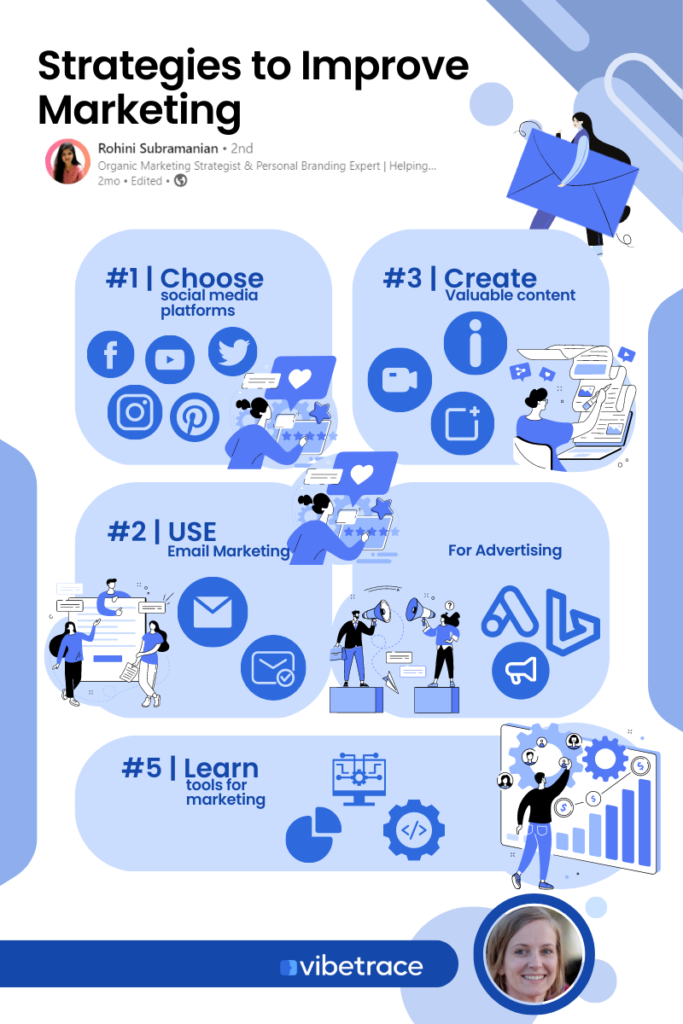
Whether you’re a freelancer looking to grow your personal brand or a business trying to expand your reach, these strategies can help you build a strong online presence and drive more traffic to your website or social media channels.
- Choose the social media platforms like Facebook, Instagram, and Twitter that make the most sense for your skill/business and create content that resonates with your audience.
- Create valuable, informative, relevant & shareable content, including blog posts, videos, carousels, posts, infographics, and more around your expertise & publish.
- Use email marketing to get in touch with your customers and nurture leads. Use email to send newsletters, promotional offers, and other valuable content to your subscribers.
- Try paid advertising, such as Google AdWords or social media ads, to quickly reach new customers. But carefully track your results to ensure that your ad spend yields a positive ROI.
- Learn to use tools like Google Analytics to analyze, optimize & track the performance of your digital marketing efforts. Make data-driven decisions to improve your campaigns.
10 Principles of Copywriting for your Business
If you’re looking to improve your business’s marketing efforts, then having a strong grasp on copywriting is an absolute must.
After all, copywriting isn’t just about stringing words together – it’s about communicating ideas effectively and persuasively. As such, there are certain principles of copywriting that can help you create more effective messaging for your brand.
Here are the top 10 copywriting principles according to Jasmin Alic, a professor of copywriting, and how you can apply them to your business.
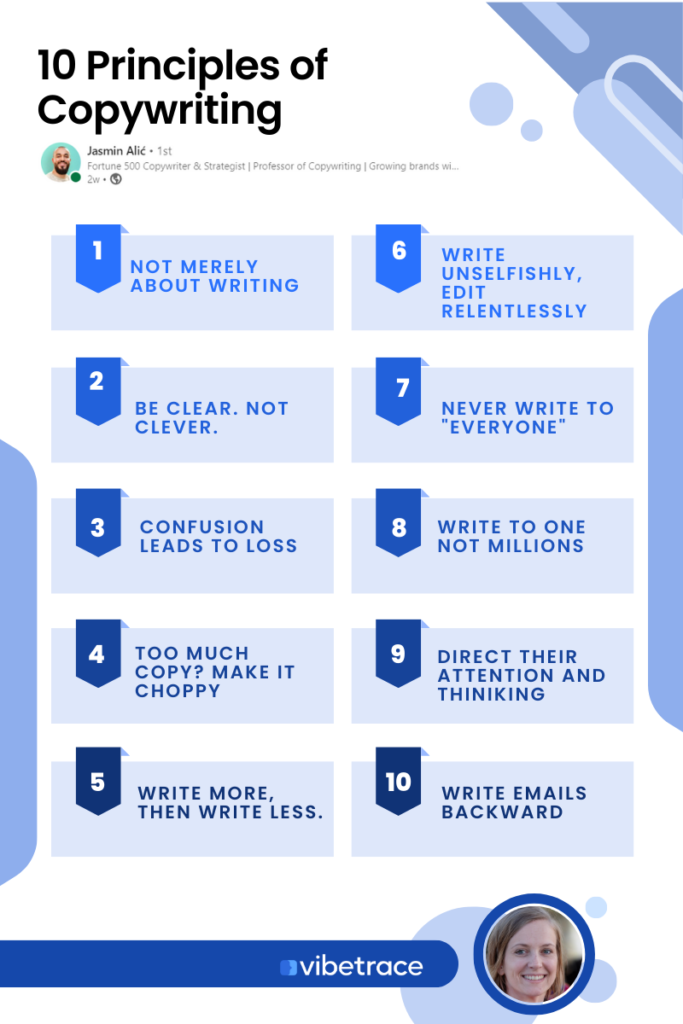
- Copywriting is not merely about writing; it involves conveying ideas and communicating effectively. While anyone can write, not everyone can communicate.
- Be clear, not clever. Always opt for simplicity rather than creativity. For example, instead of using complex phrasing like “All things crypto. All in one place,” write, “Coinbase provides the best crypto in one location. Start today.”
- Confusion leads to loss. Your audience should never question or overthink your words. Keep your message clear and straightforward. Avoid writing that is overly creative.
- Break long sentences into smaller, more manageable ones. While lengthy sentences may be necessary to convey information, they can be challenging to read. Shorter sentences are easier to read and understand.
- Start by writing more, then pare it down to less. The first draft is rarely the final draft. Start by writing down every idea, good or bad, and then begin editing.
- Write unselfishly and edit ruthlessly. Do not become attached to any particular copy. Only the best copy will survive.
- Avoid writing for “everyone.” It is essential to have a clear understanding of your target audience’s tone, level of knowledge, and priorities.
- Write as if you are having a one-on-one conversation.
- Direct your audience’s attention and thinking. Remember that copy is not just text; it is also visual.
- Proper formatting can make a significant impact. White space, sentence length, headings, subheadings, and lists can all enhance the reader’s experience.
By understanding these principles and putting them into practice, you can elevate your copywriting game and ultimately drive more sales and revenue for your business.
When you write, make it about them so they’ll make it about you
When writing your copy, always ask yourself the following questions:
- What is the reader going to see and read?
- What is the reader going to understand?
- Is this clear enough to convince them?
- Is there any room for improvement?
Remember that being a good writer improves not just your content creation skills, but also your understanding of others, thought process, authority, positioning, marketing, and more. Ultimately, writing better leads to sell better.
3 Framework to Grow and Protect Your Revenue
This 2023, it’s crucial to demonstrate measurable results rather than hiding behind strategies and plans.
To become revenue-critical, you need to focus on growing and protecting revenue, either directly or indirectly. Anything else is losing revenue.
To help you get started, here’s a framework called Build, Optimize, or Accelerate which was explained further by Devin Reed in his LinkedIn post.
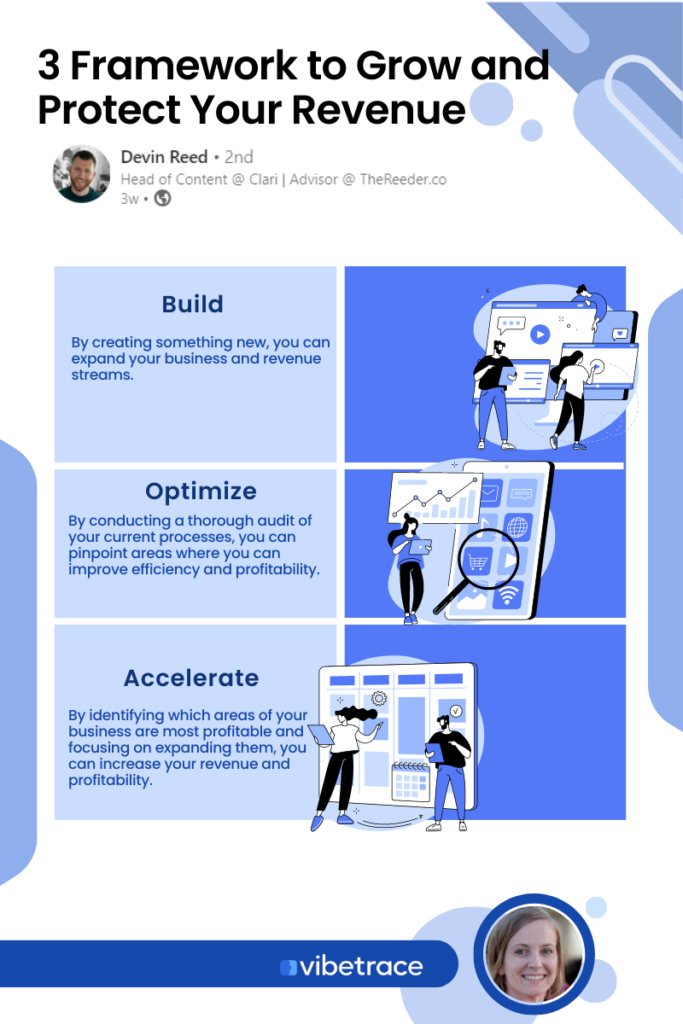
These are your options when you want to grow.
Build
This involves creating new projects, channels, and programs from scratch.
These initiatives, such as launching a thought leadership podcast or starting a newsletter, are exciting and have significant potential but take longer to yield results.
Optimize
This involves auditing your performance engine, identifying leaks, and running tests to fix them.
Examples include A/B testing subject lines in your popular nurture cadence, increasing landing page conversion rates, or finding technical errors in your SEO pages.
Also make sure you have checked our subject line generator
This option may be less glamorous to some, but it provides the quickest path to results.
Accelerate
This requires prioritizing your most productive outputs and scaling them up.
This could involve increasing your email marketing output, publishing one more SEO blog every month, or doubling your webinar velocity. However, to free up bandwidth for this option, you may need to do less or stop less effective things.
2023 won’t be an easy year, but it’s not an excuse. It’s an opportunity to adapt and test yourself. With a plan to grow or protect your revenue, you can have a legendary year despite the obstacles in your way.

